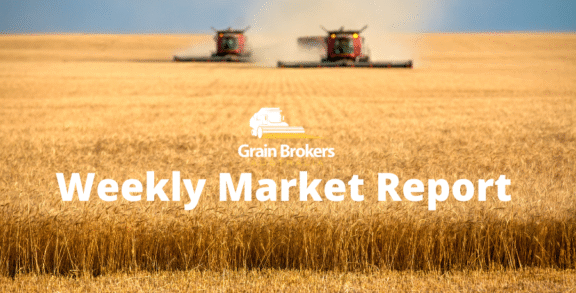
Santa overwhelmed with orders for rain…
The southern hemisphere’s second biggest wheat producer is Argentina. Heavy rain across a large portion of the country’s northern wheat production region in the past week bought harvest to a halt and started to raise quality concerns for the area yet to be reaped. The forecast for more rain over the next week has added to the market’s anxiety.
The extreme weather comes on the back of frosts in the later maturing central and southern wheat growing regions that will also have quality and quantity ramifications as the harvest moves south. The province of Buenos Aires was the hardest hit by the latest frost which arrived right in the middle of the critical flowering period.
Further west, hail storms hit the wheat crops in the southern parts Cordoba and the northern reaches La Pampa as the crop was moving to the end of the grain fill stage. Again, this is expected to manifest itself in lower yields and poorer quality in the affected areas.
As a result, the Rosario Grain Exchange has reduced its production estimate to 18.7 million metric tonnes (mmt). This is a 3.6 per cent reduction on their early November estimate of 19.4mmt. The exchange reported that the pace of the wheat harvest was slower than normal at around 52 per cent completed compared to 58 per cent at the same time last year.
According to the Buenos Aires Grain Exchange, the average wheat yield is running at 2.71 metric tonnes per hectare and there was just over 9.5mmt in the bin as at Thursday last week. Even though recent weather events have decreased final production expectations, it is still expected to be around 7 per cent higher than last season.
Like Australia, harvest usually brings a fall in prices as supply increases sharply. However, the market has moved in the opposite direction on the back of lower production and strong export demand, primarily at the expense of Australia. Values for 12 per cent protein wheat have reportedly risen around 5 per cent in the last week, trading on Thursday at US$223 Free on Board (FOB) for January loading up river. That market was subsequently offered at US$228 FOB.
Up river refers to the Paraná River ports west (or up river) of Buenos Aires. The Paraná River is the second longest river in South America at 4,880 kilometres in length and runs through Brazil, Paraguay, and Argentina. It is an extremely important trade pathway for both Argentina and the landlocked country of Paraguay. The volume of water that flows into the Atlantic Ocean via the Río de la Plata roughly equals that of the Mississippi River.
In the meantime, Egypt (GASC) unexpectedly dropped into the market last week and picked up another 180,000 metric tonnes (three cargos) of wheat for early February 2019 shipment. Russia sold two cargoes and Romania the other, but the big surprise was the price which was around US$6 higher than their purchases only a week earlier.
The higher price paid by GASC this week appears to be a reflection of declining Russian supply and less aggressive offers as the local farmers are reportedly holding onto their remaining stocks in the expectation of better prices. Russian 12.5 per cent protein wheat reportedly closed the week offered at around US237 FOB for panamax capable ports.
The talk of Russian export restrictions reared its ugly head again this week. It seems that every time the government arranges to meet exporters (another meeting scheduled for December 21) the rumour mill goes into overdrive. Maybe the threat of restrictions, solid domestic demand and the increased grower resolve will be enough to do the job without government intervention. Only time will tell!
The United States Department of Agriculture (USDA) still has Russia in for 36.5mmt of wheat exports. But they are the only ones that believe it. The current export pace supports that number. However, lower production (70mmt compared to 85mmt last year) and increasing internal prices, going into their winter, certainly suggest it is not possible.
Talk in Australian markets over the past week was dominated by the forecast of widespread rainfall throughout the summer cropping regions of northern New South Wales and Queensland. The rain arrived on time and some localised recordings, particularly on the inner Downs, were better than expected. Nonetheless, in general, the falls to date have disappointed compared to the lofty forecasts. I guess that has been a consistent theme throughout 2018.
Sorghum values moved lower across the week on the back of the optimistic weather forecasts with bids dropping below AU$350 delivered Darling Downs before rising slightly to close the week. However, wheat values have remained firm and with sorghum quoted at a discount of at least AU$80, the sellers were simply not engaging the market. With Western Australian wheat (the major stockfeed alternative) reportedly finding robust export demand, who could blame them?
The huge spread between sorghum and wheat values delivered into the key Darling Downs and Brisbane consumption markets appears to be reflecting a new crop sorghum production number of well over 2mmt. Based on reported seed sales, that is probably conservative. Based on reality, there is one key requirement before this becomes conceivable. More rain!
The precipitation over the last four days has been fantastic and welcomed. But more widespread falls are required across northern New South Wales and southern Queensland to stem the rate of sorghum abandonment, give the surviving crop a good drink, and ensure that the unplanted areas are sown as soon as possible.
And Central Queensland requires more rainfall across almost the entire region so that growers can plant their sorghum in the ideal New Year seeding window to maximize yield potential.
I think I know what most summer crop growers down under have ordered for Christmas.
Peter McMeekin is a consultant to Grain Brokers Australia. Call 1300 946 544 to discuss your grain marketing needs.





